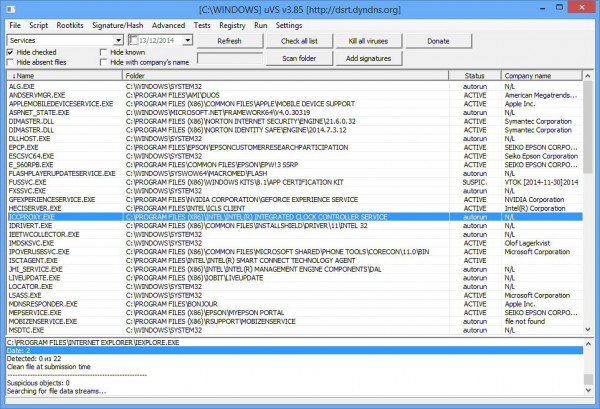
If you run, download or otherwise access malware, then your regular antivirus software should normally detect the threat, step in and remove it for you, entirely automatically.
Brand new threats might bypass this layer of protection, though, infecting your system. Getting rid of them will then be extremely difficult, but if you’re a Windows expert, and armed with a copy of Ultimate Virus Sniffer, there just might be a chance.
The program is free, portable, and runs on anything from Windows 2000 up. Unzip it, run Start.exe and in under a minute you'll have a list of suspect files. This initial scan isn’t even faintly reliable – it’s using very basic heuristics, not a virus database – and raised only false alarms for us, so we wouldn't rely on this too much.
Ultimate Virus Sniffer gets much more interesting when you begin to explore the other views on offer. It’s able to list running processes, loaded modules, Windows services, startup programs, codecs/ filters, network adapters, active programs with network connections, scheduled tasks, processes without visible windows, the contents of your host file, and much more.
The presentation of this information is generally poor (it's just dumped in a basic table), but Ultimate Virus Sniffer makes up for this with some very lengthy context menus. Right-click a process, for instance, and you’ll find options to open its folder, check it at VirusTotal/ SystemExplorer.net/ Runscanner.net/ Virusscan.Jotti.org, verify its digital signature, restore the original file with Windows SFC, unload or delete it, disable it using direct disk access (so bypassing any permissions issues or rootkit hooks), or maybe just prevent it from being run.
Browsing the rest of the menus reveals even more features. The program can detect hidden modules or a tweaked MBR (maybe), find file data streams, back up and restore the Registry, launch common Windows tools, verify files with hashes or digital signatures, run custom scripts, and more.
While this is technically impressive, the interface is basic in the extra. We expected the folder selector to be at least a little Explorer-like, for instance, but no: it’s just two listboxes and a few text buttons. You don’t get any choice of views, no context menus. You can't even resize the listboxes or the selector window, which meant that only the first 36 characters of any file name were visible.
Ultimate Virus Sniffer is still worth the download as a system information tool, and it does have plenty of malware-detecting (and general PC troubleshooting) power. Just be prepared for various usability hassles as you try to find your way around.
And, please note, some of the tools here -- like the ability to rewrite your MBR -- can seriously damage your PC if they're used incorrectly. Treat the program with extreme care.

